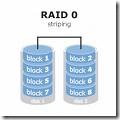
Which RAID Mode Should You Choose?
1. Speed (RAID 0)
Set in high-performance mode (also called striped mode or RAID 0) the storage system gives you the power you need when you’re:
- Designing huge graphics and need a lightning-fast Photoshop scratch space.
- Recording large DV files while maintaining clean audio performance.
- Editing DV or HD video and want a smooth work flow with no dropped frames.
- Rendering complex 3D objects or special effects.
- Performing disk-intensive database operations.
- Driven to be the first geek on your block with a computer so fast it blows your
socks off.
- Why is RAID 0 so fast? It’s a bit complicated, but suffice it to say that two or more heads, or in this case, drives, are better than one. Picture multiple hoses filling a bucket at the same time or several men bailing a boat and you can understand why two drives striped are
faster
- than one. Data is saved (striped) across both drives and accessed in parallel by all the drives so you get
higher data transfer rates
- on large data accesses and
higher input/output rates
- on small data accesses.
2. Data protection (RAID 1)
Set the system to data protection mode (also known as mirrored mode or RAID 1) and the capacity is divided in half. Half of the capacity is used to store your data and half is used for a duplicate copy.
Why do I want that kind of redundancy? It’s your data, your family pictures, your movie of baby’s first steps, your first novel. Is it important? You decide. If it is, then RAID mirroring is for you.
3. Data protection and speed (RAID 5)
In systems with three or more drives. we recommend that you set the system to RAID 5. This gives you the best of both worlds: fast performance by striping data across all drives; data protection by dedicating a quarter of each drive to fault tolerance leaving three quarters of the system capacity available for data storage.

